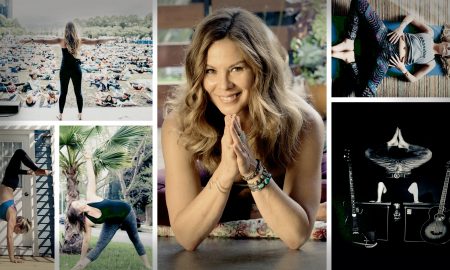

Today we’d like to introduce you to Danielle Lacharite Brown.
Danielle Lacharite, let’s start with your story. We’d love to hear how you got started and how the journey has been so far.
I’m originally from New Hampshire, where I attended the University of New Hampshire and secured my undergraduate degree in Anthropology and Art History. My intention was to be an archaeologist and work in a museum someday.
I moved to NYC shortly after graduation, where I worked at the Metropolitan Museum of Art in the Membership Department. I learned that there is a real business to running a cultural attraction and dedicated myself to learning best practices from one of the greatest museums in the world.
I moved to Los Angeles on a whim in the late nineties thinking I’d stay a year and move back to New England, but 20 years later I still can’t get enough of this wonderful place, everyday feels like a vacation, the weather is so nice and the people in LA are so friendly and outgoing.
I worked for the Los Angeles County Museum of Art and spent the last 14 years working at the Natural History Museum as the Vice President of Annual Giving, helping that Museum reimagine itself. After our renovations were complete, I wanted to try something new,
I joined the South Coast Botanic Garden in January as Chief Development Officer. I am overseeing fundraising, marketing, guest services, programs, education and special events. My focus is on enhancing our experiences — whether for guests, members, donors, or school children, and building our financial resources so that we can fulfill our ambitious vision plan that will reimage our beloved garden.
I live in Long Beach with my husband, Charlie Brown, and two young children Wyatt and Violet. In my spare time I play the Ukulele, compete in scavenger hunts with my husband, make intricate Halloween costumes for my family and take road trips and daytrips to cultural attractions with my kids.
Great, so let’s dig a little deeper into the story – has it been an easy path overall and if not, what were the challenges you’ve had to overcome?
I’ve just arrived at the South Coast Botanic Garden, so I can’t really say I’ve faced any real struggles here yet. Although my fashion struggle is real, transitioning from suits and heels at NHM to garden suitable pants, flat shoes and garden boots was a real feat! I had no less than 7 pairs of pants hemmed to accommodate my new flat shoes and I am still working on the flat shoes because even my sneakers are too fancy for our muddy spring trails!
As far as the work goes, I see a whole mountain of work in front of me. I want to make new experiences for our guests and donors and I want to foster strong relationships with the community. The heap of work is what attracted me to this place, there is a real opportunity for creativity and success. I often need to take a pause and remember that this is a marathon, not a sprint!
The Garden has a great team in place, a small but nimble staff who is dedicated to our success. There is a strong 25-year Vision Plan that is setting the tone for a great reimagining of this 87-acre property. The Board of Trustees is committed to the Vision Plan and to making this the best Garden possible. And, our public/private partnership with the County of Los Angeles and the Garden Foundation is stronger than ever.
The struggle of balancing work and family and my desire to be a domestic goddess like Martha Stewart is real. I tend to “lean in” to the business during my allotted worktime and then I shut it off and invest time with my domestic life as if it is my second shift of the day. My drive home is my time to refresh and reset … I listen to a trashy novel on audio and by the time I get home I am ready to make dinner, do homework and give baths. My husband, of course, is a huge support — we are a real team. In fact, we both have the same birthday (June 5) and so we often refer to ourselves as “Team Gemini” for our horoscope sign. 🙂
Please tell us about South Coast Botanic Garden.
The South Coast Botanic Garden has a really interesting story — once an open pit mine, then a garbage landfill — the County of Los Angeles decided to plant a garden atop the landfill after it was capped. What results is a fascinating experiment in land reuse and a vibrant story of rebirth and rejuvenation.
Today the garden is an oasis in our metropolis, a space where you can get away and take in a fresh breath. Flowers bloom throughout the year and 87 acres of nature space offers many opportunities for adventure. Though, the best thing to do here is nothing at all — sit quietly amid the trees and listen to the birds and the insects flying by and the rustle of leaves from our tall trees.
I see guests coming to enjoy their daily walk with a few laps around our mile loop, there are families who come for nature walks amid our dirt trails and tall trees, and others who come for rehabilitation and healing. Our public programs offer something for everyone, whether Yoga on the meadow, music on the green, or art classes.
The schoolchildren who visit the garden are really fun to see. They are often coming in from the urban core of our city and rarely do they have homes with yards or even nearby green space. When they arrive, they are thrilled to be able to kick off their shoes in our grassy meadows and to take a nature excursion with our docents. Just last week I tagged along with a school from South LA and the kids were very excited to see a rabbit hiding in the bushes — they had never seen one in the wild before. This opportunity for nature connectivity is important.
The Garden is also an important habitat — with exquisite birds like hummingbirds, hawks and even Great Horned Owls! I’d been hoping to see an owl for the last month or so and never had any luck. But then, one night as I was walking out with one of our Board Members she offered to “call the owls.” A quick “whooo whoo” and the hooting began, answering back and forth amid the trees and we even got a direct fly over. It was my favorite Garden moment yet!
The Garden is probably best known for its Banyan Grove, an unusual planting of large ficus trees that creates a unique shaded woodland habitat that looks like something a magical garden gnome would call home.
Cherry blossoms are abundant in the spring, with stunning pale pink lace decorating the property.
What’s most exciting is the future vision for this Garden. Our Vision Plan has plotted out a reimagining of our campus, with a series of specialty gardens and site renovations that will take place over the next 25 years. We’ve already begun the transformation with our Rose Garden Project, which is currently under construction. Expected to be complete next fall, the new Rose Garden was designed by Deborah Richie-Bray, the landscape designer of the Getty Villa. The formal garden will provide celebration space, relaxation alcoves, a sculpture garden, and a vast array of rose cultivars. What is particularly exciting is that the new Rose Garden will be completely accessible to all visitors, with wide paths and access points so that everyone can get up and smell the roses.
Next up will be our Children’s Garden, which will redefine the genre with ample opportunities to connect children with nature in a safe setting where parents can let their kids have some fun. Additional plans include a Native Plant Garden, a Japanese Garden, a revitalized Lake, and much more.
From a design perspective, our plan really takes advantage of the quirky nature of this reclaimed space. The landfill below our plant beds is constantly settling and in some places, it keeps the ground temperature a bit warm. This means we have rolling hills and dips and valleys throughout the property, and hot spots where deeply rooted plants are difficult to grow. Rather than fighting our changing topography, we are embracing the unusual shape of the ground as a benefit to our landscape design.
Do you look back particularly fondly on any memories from childhood?
Growing up in New Hampshire, we had a ton of space to play outside. Every home had at least an acre of property, which means sprawling lawns. We lived near a brook and that attracted a lot of garter snakes to our yard. I have a distinct memory of stepping on a snake with my bare feet and squealing in terror as a result.
I still shiver to think about it, and now I have a pretty healthy fear of snakes. For years, I wouldn’t walk barefoot in grass, not even in Central Park when I lived in New York City.
What is funny is that the South Coast Botanic Garden doesn’t have any snakes on the property. We aren’t sure why exactly, but I have a theory that it has something to do with the elevated ground temperature. Either way, I’m thrilled to kick off my shoes and walk barefoot in the meadow without fear!
Pricing:
- General Admission is $9 for adults adn $4 for children. Members and Kids 4 and under are free.
Contact Info:
- Address: South Coast Botanic Garden
26300 Crenshaw Blvd
Palos Verdes Peninsula CA 90274 - Website: southcoastbotanicgarden.org
- Phone: 310-544-1948
- Email: [email protected]
- Instagram: scbgarden
- Facebook: scbgarden
- Twitter: scbgarden



Trichocereus spachianus
























